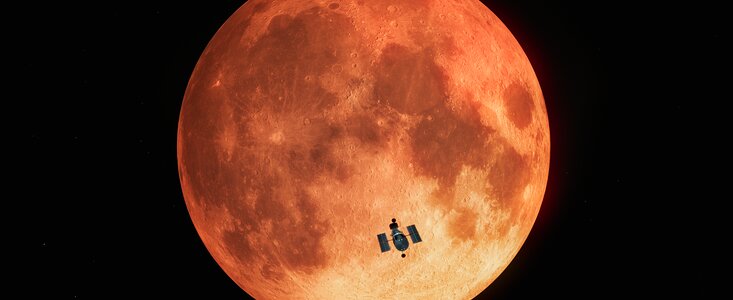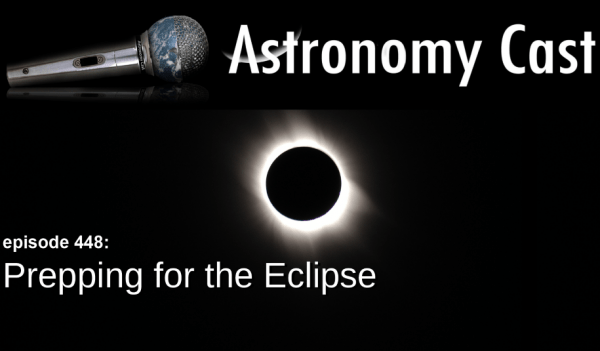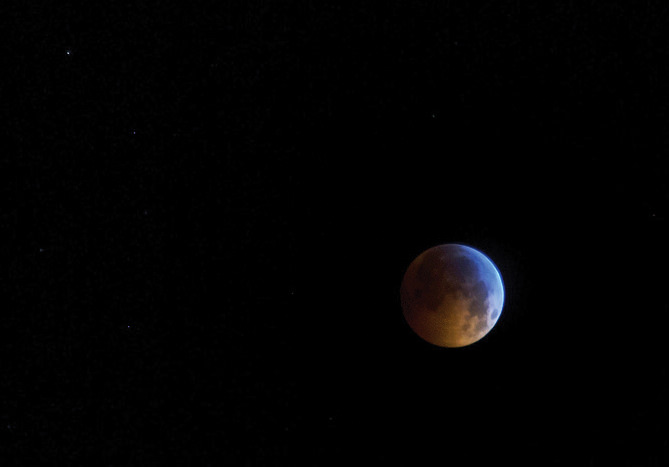What would we look for in a distant exoplanet in the hunt for Earth-like worlds, and perhaps life? A recent observation carried out by the Hubble Space Telescope found tell-tale signatures from our home planet by looking at a familiar source under extraordinary circumstances: Earth’s Moon, during a total lunar eclipse.
Continue reading “Hubble Examines Earth’s Reflection as an ‘Exoplanet’ During a Lunar Eclipse”Astronomy Cast Ep. 448: Prepping for the Eclipse
On Monday, August 21, 2017, there’s going to be a total eclipse of the Sun, visible to path that goes right through the middle of the United States. You should be making plans to see this, and we’re here to help you know where to go and what to do.
Visit the Astronomy Cast Page to subscribe to the audio podcast!
We usually record Astronomy Cast as a live Google+ Hangout on Air every Friday at 1:30 pm Pacific / 4:30 pm Eastern. You can watch here on Universe Today or from the Astronomy Cast Google+ page.
What is a Total Eclipse?
Imagine if you will, that you are a human being living in prehistoric times. You look up at the sky and see the Sun slowly being blocked out, becoming a ominous black sphere that glows around the edges. Could you really be faulted for thinking that this was some sort of supernatural event, or that the end of the world was nigh?
Of course not. Which is why for thousands of years, human beings believed that solar eclipses were just that – a sign of death or a bad omen. But in fact, an eclipse is merely what happens when one stellar object passes in front of another and obscures it. In astronomy, this happens all the time; and between the Sun, the Moon, and the Earth, total eclipses have been witnessed countless times throughout history.
Definition:
The general term for when one body passes in front of another in a solar system is transit. This term accurately describes how, depending on your vantage point, stellar bodies pass in front of each other on a regular basis, thus causing the reflected light from that body to be temporarily obscured.
However, when we are talking about how the Moon can pass between the Earth and the Sun, and how the Earth can pass between the Sun and the Moon, we use the term eclipse. This is also known as a syzygy, an astronomical term derived from ancient Greek (meaning “yoked together”) that describes a straight-line configuration between three celestial bodies.
Total Solar Eclipse:
When the Moon passes between the Sun and the Earth, and the Moon fully occults (blocks) the Sun, it is known as the solar eclipse. The type of solar eclipse – total or partial – depends on the distance of the Moon from the Earth during the event.
During an eclipse of the Sun, only a thin path on the surface of the Earth is actually able to experience a total eclipse – which is called the path of totality. People on either side of that path see a partial eclipse, where the Sun is only partly obscured by the Moon, relative to those who are standing in the center and witnessing the maximum point of eclipse.
A total solar eclipse occurs when the Earth intersects the Moon’s umbra – i.e. the innermost and darkest part of its shadow. These are relatively brief events, generally lasting only a few minutes, and can only be viewed along a relatively narrow track (up to 250 km wide). The region where a partial eclipse can be observed is much larger.
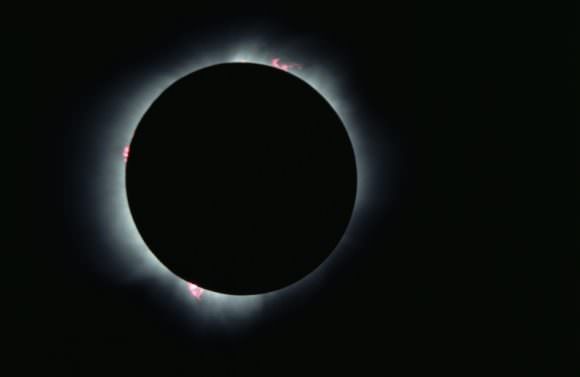
During a solar eclipse, the Moon can sometimes perfectly cover the Sun because its size is nearly the same as the Sun’s when viewed from the Earth. This, of course, is an illusion brought on by the fact that the Moon is much closer to us than the Sun.
And since it is closer, it can block the light from the Sun and cast a shadow on the surface of the Earth. If you’re standing within that shadow, the Sun and the Moon appear to line up perfectly, so that the Moon is completely darkened.
After a solar eclipse reaches totality, the Moon will continue to move past the Sun, obscuring smaller and smaller portions of it and allowing more and more light to pass.
Total Lunar Eclipse:
A total eclipse of the Moon is a different story. In this situation, the entire Moon passes into the Earth’s shadow, darkening it fully. A partial lunar eclipse occurs when the shadow of the Earth doesn’t fully cover the Moon, so only part of the Moon is darkened.
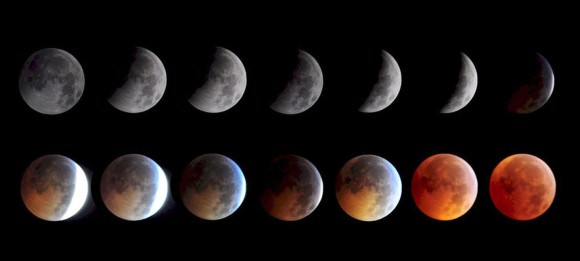
Unlike a solar eclipse, a lunar eclipse can be observed from nearly anywhere in an entire hemisphere. In other words, observers all across planet Earth can see this darkening and it appears the same to all. For this reason, total lunar eclipses are much more common and easier to observe from a given location. A lunar eclipse also lasts longer, taking several hours to complete, with totality itself usually averaging anywhere from about 30 minutes to over an hour.
There are three types of lunar eclipses. There’s a penumbral eclipse, when the Moon crosses only the Earth’s penumbra (the region in which only a portion of light is obscured); followed by a partial, when the Moon crosses partially into the Earth’s umbra (where the light is completely blocked).
Last, there is a total eclipse, when the Moon crosses entirely into the Earth’s umbra. A total lunar eclipse involves the Moon passing through all three phases, then gradually passing out of the Earth’s shadow and becoming bright again. Even during a total lunar eclipse, however, the Moon is not completely dark.
Sunlight is still refracted through the Earth’s atmosphere and enters the umbra to provide faint illumination. Similar to what happens during a sunset, the atmosphere scatters shorter wavelength light, causing it to take on a red hue. This is where the phrase ‘Blood Moon‘ comes from.
Since the Moon orbits the Earth, you would expect to see an eclipse of the Sun and the Moon once a lunar month. However, this does not happen simply because the Moon’s orbit isn’t lined up with the Sun. In fact, the Moon’s orbit is tilted by a few degrees – 1.543º between the angle of the ecliptic and the lunar equator, to be exact.
This means that three objects only have the opportunity to line up and cause an eclipse a few times a year. It’s possible for a total of 7 solar and lunar eclipses every year, but that only happens a few times every century.
Other Types of Eclipses:
The term eclipse is most often used to describe a conjunction between the Earth, Sun and Moon. However, it can also refer to such events beyond the Earth–Moon system. For example, a planet moving into the shadow of one of its moons, a moon passing into the shadow of its host planet, or a moon passing into the shadow of another moon.
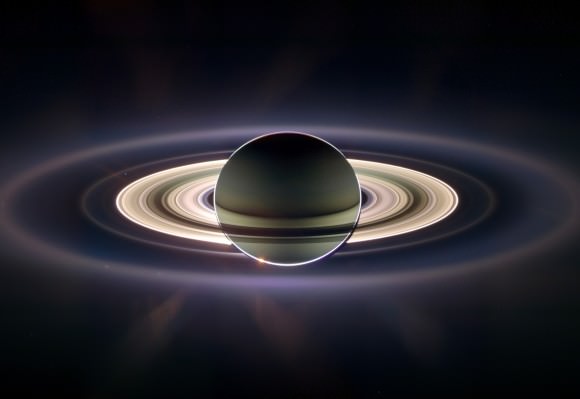
For instance, during the Apollo 12 mission in 1969, the crew was able to observe the Sun being eclipsed by the Earth. In 2006, during its mission to study Saturn, the Cassini spacecraft was able to capture the image above, which shows the gas giant transiting between the probe and the Sun.
In July of 2015, when the New Horizons mission passed through the shadow of Pluto, it was able to capture a stunning image of the dwarf planet eclipsing the Sun. The image was taken at a distance of about 2 million km (1.25 million miles), which provided the necessary vantage point to see the disc of the Sun become fully obscured.
On top of that, many other bodies in the Solar System can experience eclipses as well. These include the four gas giants, all of which have major moons that periodically transit between the planet and either Earth-based or space-based observatories.
The most impressive and common of these involve Jupiter and its four largest moons (Io, Europa, Ganymede and Callisto). Given the size and low axial tilt of these moons, they often experience eclipses with Jupiter as a result of transits, relative to our instruments.
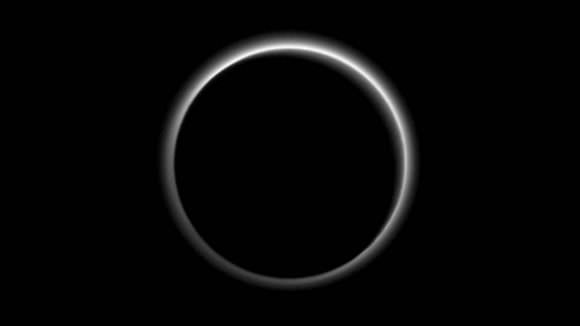
A well-known example occurred in April of 2014, when the Hubble Space Telescope caught an image of Ganymede passing in front at of Jupiter. At the time the image was taken, Ganymede was casting its shadow within Jupiter’s Great Red Spot, which lent the planet a cyclops-like appearance (see below).
The other three gas giants are known to experiences eclipses as well. However, these only occur at certain periods the planet’s orbit of the Sun, due to their higher inclination between the orbits of their moons and the orbital plane of the planets. For instance, Saturn’s largest moon Titan has been known to only occult the ringed gas giant once about every 15 years.
Pluto has also been known to experience eclipses with is largest moon (and co-orbiting body) Charon. However, in all of these cases, the eclipses are never total, as they do not have the size to obscure the much larger gas giant. Instead, the passage of the moons in front of the larger celestial bodies either cast small shadows on the cloud tops of the gas giants, or lead to an annular eclipse at most.
Similarly, on Mars, only partial solar eclipses are ever possible. This is because Phobos or Deimos are not large enough (or distant enough in their orbits) to cover the Sun’s disc, as seen from the surface of the planet. Phobos and Deimos have also been known to experience lunar eclipses as they slip into the shadow of Mars.
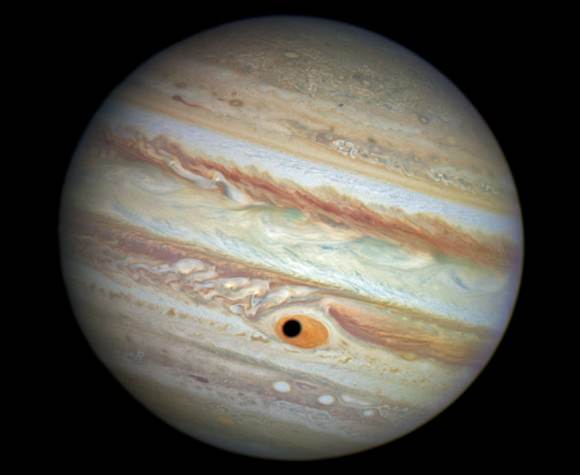
Martian eclipses have been photographed numerous times from both the surface and from orbit. For example, in 2010, the Spirit rover captured images of a Martian lunar eclipse as Phobos, the larger of the two martian moons, was photographed while slipping into the shadow of Mars.
Also, between Nov. 4 and Nov. 5, 2010, the Opportunity rover captured several images (later turned into movies) of a Martian sunset. In the course of imaging the Sun for a total of 17 minutes, Opportunity captured stills of the Sun experiencing a solar eclipse. And on September 13th, 2012 – during the 37th day of its mission (Sol 27) – the Curiosity rover captured an image of Phobos transiting the Sun.
As far as astronomical events go, total eclipses (Lunar and Solar) are not uncommon occurrences. If you ever want to witness a one, all you need to do is keep track of when one will be visible from your part of the world. Some good resources for this are NASA’s Eclipse Website and timeanddate.com.
Or, if you’re the really adventurous type, you can find out where on Earth the next path of totality is going to be, and then book a vacation to go there. Get to the right spot at the right time, and you should be getting the view of a lifetime!
We have written many articles about the eclipse for Universe Today. Here’s a list of articles about specific times when a total Lunar Eclipse took place, and here’s a list of Solar Eclipse articles. And be sure to check out this article and video of an Annular Eclipse.
If you’d like more info about the Eclipse, check out NASA Homepage, and here’s a link to NASA’s Solar System Simulator.
We’ve also recorded related episodes of Astronomy Cast about Eclipses. Listen here, Episode 160: Eclipses.
Sources:
DSCOVR Captures EPIC Views of the March 2016 Eclipse
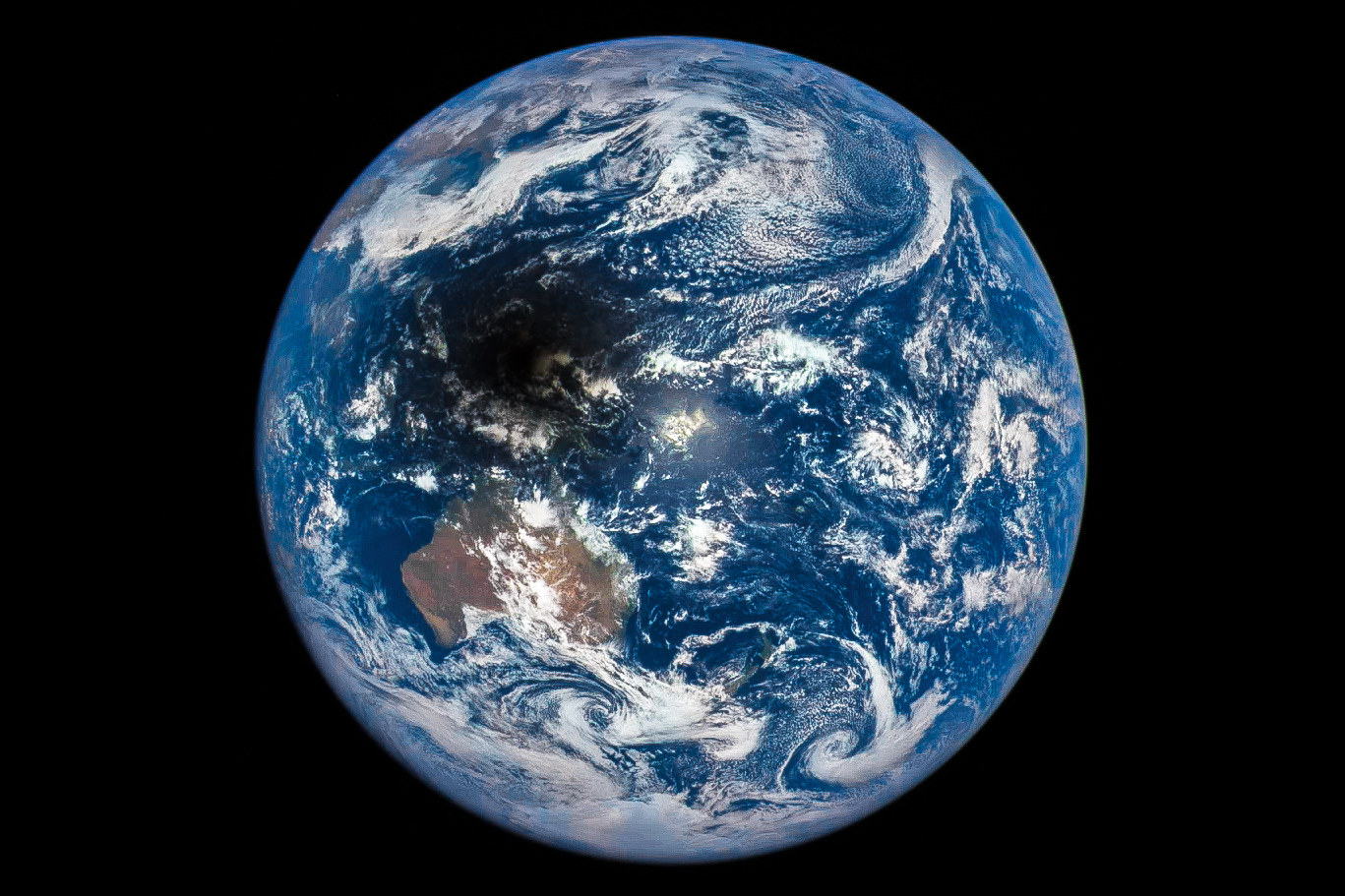
On March 8, 2016 (March 9 local time) the Moon briefly blocked the light from the Sun in what was the only total solar eclipse of the year. The event was visible across portions of southeast Asia, Indonesia, and Micronesia, and was observed by both skywatchers on the ground in person and those watching live online around the world. While to most the view was of a silhouetted Moon slowly carving away the disk of the Sun before totality revealed a shimmering corona, the view from space looking back at Earth showed the Moon’s dark shadow passing over islands, clouds, and sea.
Continue reading “DSCOVR Captures EPIC Views of the March 2016 Eclipse”
And The Moon Is Eclipsed By The Earth
[/caption]
On June 15 there will be a total lunar eclipse visible from Australia, Indonesia, southern Japan, India, a large area of Asia, Africa, Europe and the eastern part of South America. This is expected to be one of the darkest eclipses ever (with a magnitude of 1.7), second only to the July 2000 eclipse.
Sadly it won’t be visible to viewers in North America, but much of the rest of the world should be treated to a wonderful show as the Moon slips into Earth’s shadow. Gradually growing darker from its western limb inwards, the Moon then gains a bluish cast which transitions to orange then deep red as it moves into light passing through the edge of Earth’s atmosphere (the same as what makes the colors of a sunset) and then eventually going almost completely dark before the process then reverses itself from the opposite side.
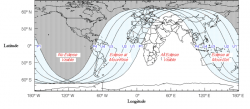
The entire eclipse will last 5 hours and 39 minutes, with a totality duration of 1 hour and 40 minutes. It will begin at 17:23 UT.
Viewers in Australia and eastern Asia will see the eclipse begin as the Moon is setting while those in Europe and South America will see it as the Moon is rising. Only locations in India, eastern Africa, the Middle East and western Asia will experience the entire eclipse.
This is the first of two total lunar eclipses in 2011; the next will take place on December 10.
I saw my first total lunar eclipse last December, which took place on the night of the winter solstice (December 21). It really was an amazing event to watch… in totality the Moon was colored a deep coppery red and really just seemed to be suspended among the stars – it felt like you could just reach up and pluck it from the sky! If you are in any of the areas where this next one is visible I encourage you to check it out for yourself!
Read more about lunar eclipses on MrEclipse.com.
Image: Jason Major

